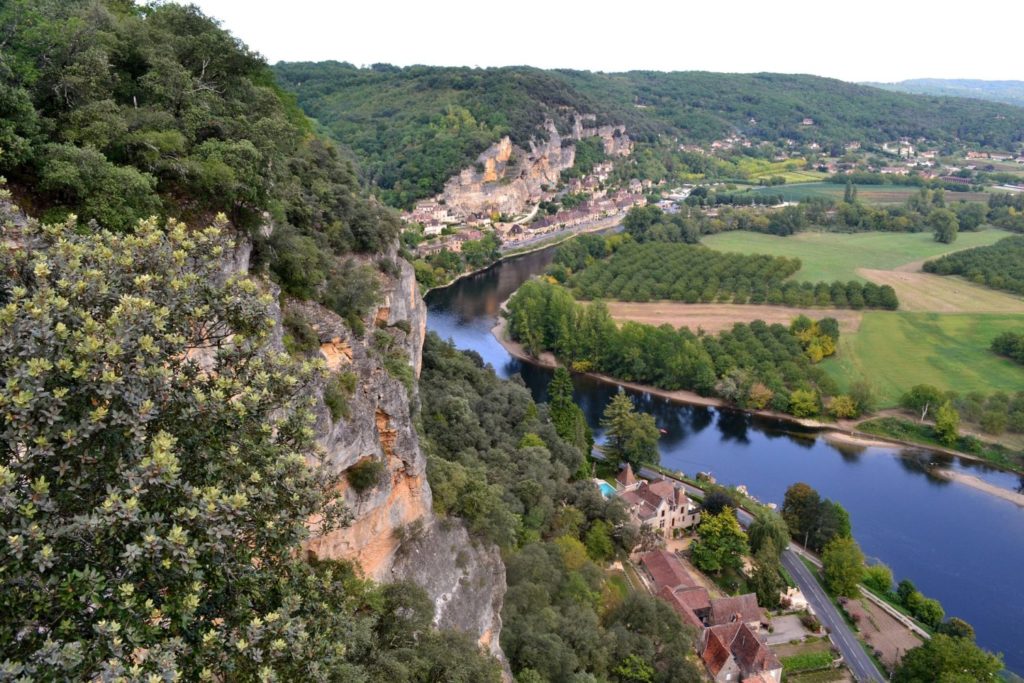Canoeing the Dordogne

Canoeing the Dordogne
The Dordogne River flows west through the South West of France, snaking through the soaring cliffs dotted by ancient châteaux and some of the most beautiful villages in France in the Périgord Noir. One of the best ways to experience this stunning part of France is by grabbing some paddles and canoeing the Dordogne.
A Dordogne canoe trip can last from just a few hours to several days while also camping along the Dordogne’s shores. A Dordogne canoe trip can even combine adventure and luxury with a stay in a château converted to a luxury hotel along the way. But no matter whether you canoe the Dordogne on a day trip or on a multi-day Dordogne holiday, this French adventure needs to be on your bucket list.
How to Spend a Day Canoeing the Dordogne from Vitrac to Beynac
For a day out on the Dordogne, the 16 kilometer route from Vitrac to Beynac is one of the most beautiful parts of the Dordogne River. The route encompasses five clifftop castles and three of the most beautiful villages in France on a calm part of the river perfect for any canoeing experience level.
It takes around 3 hours to canoe from Vitrac to Beynac, and there is a shuttle back to the launch point in Vitrac every hour with Canoës Loisirs. There are also points that you can you paddle ashore and visit some of the villages and their attractions along the way.
Vitrac
The route begins in Vitrac, considered to be the heart of the Périgord Noir. The beautiful village, a canton of Sarlat, has a population of just 872. But Vitrac once played an essential role in Bordeaux’s wine trade with England, first as a major producer of wine barrels and then as a builder of the Gabares (a special type of rive barge). The Gabares carried planks of wood for the barrels on the river to the Gironde.
There’s also a small island near Vitrac, which is a natural bird sanctuary. The Dordogne River is, after all, a UNESCO World Biosphere Reserve. You can not only admire the beautiful scenery of the honey-colored villages you’ll gently drift past, but also the possibility to spot birds like kites, buzzards and falcons.
La Roque-Gageac
The village of La Roque-Gageac is listed as one of Les Plus Beaux Villages de France, the most beautiful villages of France. The village sits on the Dordogne River and the honey-colored houses are built right in to the massive cliff that overhangs the village.
The village has been occupied since prehistoric times, making it one of the interesting villages to visit. On a walk through the village, follow the steps up to the troglodyte fort that dates back to the Viking invasions. On Friday morning from May – September there is also a food market and there are good restaurants in the village.
The Château de La Malartrie sits on the edge of the village. The castle dates back to the 12th century when it was originally a leper hospital. It sat abandoned for many years until it was purchased by the Count de Saint Aulaire. The Count transformed the castle in the Renaissance style it stands in today. It’s actually a lovely castle hotel you can stay in with a fabulous outdoor swimming pool.
Castelnaud-la-Chapelle
A little further down the river, you come to Castelnaud-la-Chapelle. This is another of the most beautiful villages of France, which sits on the confluence of the Dordogne and Céou rivers. The village is known for its two castles.
Château Castelnaud was built in the 12th century as a show of power to face its rival castle Château de Beynac. This castle too was once abandoned and nothing more than ruins by the time of the French Revolution. The medieval fortress is beautifully restored and today is a museum of medieval warfare. You can even try your hand at archery, a discipline that was well mastered by the soldiers during the Hundred Years War, or firing a trebuchet during various times throughout the year.
The second castle of Castelnaud-la-Chapelle is Château des Milandes. It was built in 1489 by François de Caumont, the Lord of Castelnaud, as a gift to his wife. Josephine Baker purchased it in 1947 after falling in love it while renting it. And today it is a beautiful manor hour with stunning gardens, a birds of prey show and an on-site restaurant.
Beynac-et-Cazenac
The third and final of the most beautiful villages of France to pass by on the 16 kilometer canoe trip from Vitrac is the village of Beynac-et-Cazenac. This beautiful village sitting on the north bank of the Dordogne River has been the setting for a number of movies, and Americans may have seen it in Chocolat with Juliette Binoche and The Messenger: The Joan of Arc Story with Dustin Hoffman.
There are quite a few shops and restaurants in pretty Beynac, but it is best known for Château de Beynac that crowns the top of the clifftop village. Château de Beynac is the best preserved of the Dordogne’s more than 100 castles.
The oldest part of clifftop castle was built in the 12th century by the barons of Beynac. The sheer cliff face was deterrent enough, so the oldest part of the castle is a Romanesque keep built on the plateau with a double moat, double crenellated walls and a double barbican. It was enlarged in the 16th and 17th centuries.
During the Hundred Years’ War, Château de Beynac was held by the French. The Dordogne River served as the border between France and England, and Château de Castelnaud on the opposite bank was held by the English. For a brief time it was captured by Richard the Lionheart.
The castle has been listed as a monument historique (a designation given to some French heritage sites) since 1944 and was purchased and restored in 1962. Today it is like a living museum transporting visitors back to the times of Richard the Lionheart and Elinor of Aquitaine. You can explore the dungeons, great halls with their sumptuous tapestris and get an incredible 360-degree view over the Dordogne valley from the towers.
Cet article issu du site : https://luxeadventuretraveler.com/
Lien de l’article : https://luxeadventuretraveler.com/canoeing-the-dordogne/
Nous vous invitons à les découvrir !
